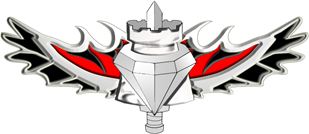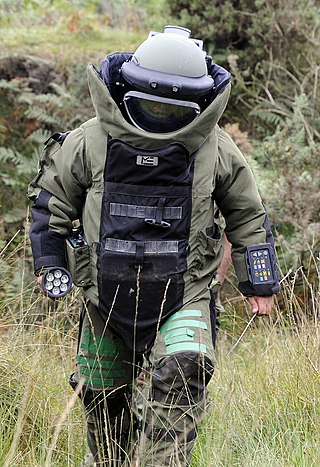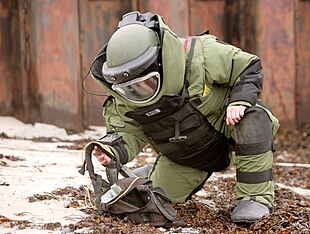
Bomb disposal is an explosives engineering profession using the process by which hazardous explosive devices are disabled or otherwise rendered safe. Bomb disposal is an all-encompassing term to describe the separate, but interrelated functions in the military fields of explosive ordnance disposal (EOD) and improvised explosive device disposal (IEDD), and the public safety roles of public safety bomb disposal (PSBD) and the bomb squad.

A bulletproof vest, also known as a ballistic vest or a bullet-resistant vest, is an item of body armour that helps absorb the impact and reduce or stop penetration to the torso by firearm-fired projectiles and fragmentation from explosions. The vest may come in a soft form, as worn by many police officers, prison officers, security guards, and some private citizens, used to protect against stabbing attacks or light projectiles, or hard form, using metallic or para-aramid components. Soldiers and police tactical units wear hard armour, either in conjunction with soft armour or alone, to protect against rifle ammunition or fragmentation.

To improve motorcycle safety, many countries mandate the wearing of personal protective equipment such as protective clothing and helmets. Protective clothing may include certain types of jackets, gloves, boots, and pants. Jackets meant for motorcyclists are typically made of leather or specialized man-made fabrics like cordura or Kevlar. These jackets typically include padding on the elbow, spine, and shoulder regions. This was once quite bulky, but modern technology and materials have made it unobtrusive. Gloves are generally made of leather or Kevlar and some include carbon fiber knuckle protection. Boots, especially those for sport riding, include reinforcement and plastic caps on the ankle and toe areas. Pants are usually leather, cordura, or Kevlar. Except for helmets, none of these items are required by law in any state in the USA, or in any part of the UK but are recommended by many of those who ride.
Overpressure is the pressure caused by a shock wave over and above normal atmospheric pressure. The shock wave may be caused by sonic boom or by explosion, and the resulting overpressure receives particular attention when measuring the effects of nuclear weapons or thermobaric bombs.

Unexploded ordnance, unexploded bombs (UXBs), and explosive remnants of war are explosive weapons that did not explode when they were employed and still pose a risk of detonation, sometimes many decades after they were used or discarded. When unwanted munitions are found, they are sometimes destroyed in controlled explosions, but accidental detonation of even very old explosives also occurs, sometimes with fatal results. A dud is an unexploded projectile fired in anger against an enemy, but which has failed to explode. A projectile not fired in anger but which has failed to explode is called a 'blind'.

Yahalom is a sayeret unit of the Israeli Combat Engineering Corps of the Israel Defense Forces (IDF). The name "Yahalom", while meaning 'diamond' in Hebrew, is also an abbreviation of "Special Operations Engineering Unit".

The Explosive Ordnance Disposal Badge is a military badge of the United States Armed Forces which recognizes those service members, qualified as explosive ordnance disposal (EOD) technicians, who are specially trained to deal with the construction, deployment, disarmament, and disposal of high explosive munitions including other types of ordnance such as nuclear, biological and chemical weapons along with improvised explosive devices (IED) and improvised nuclear devices (IND). Also known as the “EOD Badge” or "Crab", the decoration is issued by the United States Army, Air Force, Navy and Marine Corps. The EOD Badge is the only occupational badge awarded to all four services under the United States Department of Defense.

Body armor, personal armor, armored suit (armoured) or coat of armor, among others, is protective clothing designed to absorb or deflect physical attacks. Historically used to protect military personnel, today it is also used by various types of police, private security guards, or bodyguards, and occasionally ordinary citizens. Today there are two main types: regular non-plated body armor for moderate to substantial protection, and hard-plate reinforced body armor for maximum protection, such as used by combatants.

United States Navy Explosive Ordnance Disposal technicians render safe all types of ordnance, including improvised, chemical, biological, and nuclear. They perform land and underwater location, identification, render-safe, and recovery of foreign and domestic ordnance. They conduct demolition of hazardous munitions, pyrotechnics, and retrograde explosives using detonation and burning techniques. They forward deploy and fully integrate with the various Combatant Commanders, Special Operations Forces (SOF), and various warfare units within the Navy, Marine Corps, Air Force and Army. They are also called upon to support military and civilian law enforcement agencies, as well as the Secret Service.

The HLONS (HMMWV Laser Ordnance Neutralization System), commonly known as ZEUS, is a solid-state laser weapon which is used by the U.S. military in order to neutralize surface land mines and unexploded ordnance. The ZEUS-HLONS system was a co-operative effort between Sparta Inc and NAVEODTECHDIV (Naval Explosive Ordnance Disposal Technology Division) to demonstrate that a moderate-power commercial solid state laser (SSL) and beam control system could be integrated onto a Humvee (HMMWV) and used to clear surface mines, improvised explosive devices (IEDs), or unexploded ordnance from supply routes and minefields.

Bunker gear is the personal protective equipment (PPE) used by firefighters. The term is derived from the fact that the trousers and boots are traditionally kept by the firefighters bunk at the fire station to be readily available for use.

A ballistic face mask, also known as facial armor, is a type of personal armor designed to protect the wearer's face from ballistic threats. Ballistic face masks are usually made of Kevlar or other bullet resistant materials and the inside of the mask may be padded for shock absorption, depending on the design.

The use of personal protective equipment (PPE) is inherent in the theory of universal precaution, which requires specialized clothing or equipment for the protection of individuals from hazard. The term is defined by the Occupational Safety and Health Administration (OSHA), which is responsible for PPE regulation, as the "equipment that protects employees from serious injury or illness resulting from contact with chemical, radiological, physical, electrical, mechanical, or other hazards." While there are common forms of PPEs such as gloves, eye shields, and respirators, the standard set in the OSHA definition indicates a wide coverage. This means that PPE involves a sizable range of equipment. There are several ways to classify them such as how gears could be physiological or environmental. The following list, however, sorts personal protective equipment according to function and body area.

The Advanced Bomb Suit (ABS) is a full body bomb suit designed to protect explosive ordnance disposal (EOD) soldiers from threats associated with improvised explosive devices, including those related to fragmentation, blast overpressure, impact, heat, and flame. Manufactured by Med-Eng, the ABS uses new material technology and design to improve protection, comfort, and ergonomics. The suit is constructed from Kevlar with an outer anti-static cover of 50/50 Nomex/Kevlar and comprises a jacket, crotchless trousers, groin cup, and rigid ballistic panels. To minimize weight and maximize flexibility, protection is provided at various levels, specific to body regions, based on susceptibility to wounds. The suit does not provide gloves to the operator so that maximum ability on the hands is present.
Blast-related ocular trauma comprises a specialized subgroup blast injuries which cause penetrating and blunt force injuries to the eye and its structure. The incidence of ocular trauma due to blast forces has increased dramatically with the introduction of new explosives technology into modern warfare. The availability of these volatile materials, coupled with the tactics of contemporary terrorism, has caused a rise in the number of homemade bombs capable of extreme physical harm.
The Kosovo Police's Bomb Squad (IED/EOD) was established in March 2006, prompted by the necessity to protect citizens’ lives and property, and to assist in investigation of crime-related cases.

No. 5131 (BD) Squadron was an Explosive Ordnance Disposal (EOD) squadron of the Royal Air Force. First formed in 1943, 5131 Bomb Disposal Squadron was the Royal Air Force’s explosive ordnance disposal capability for 77 years. Its technicians were trained to deal with conventional munitions, chemical munitions and improvised explosive devices. The Squadron also responded to aircraft crashes; clearing the area of explosive risks and making any ordnance, aircraft assisted escape systems and flare countermeasures safe. During the 77-year operational history of the squadron, it saw action in World War II, the Suez conflict, the Indonesian conflict, the Cyprus invasion, the Falkland Islands war, Kosovo, Bosnia, Iraq, Afghanistan and Northern Ireland as well as Military Assistance to Police taskings in the UK.

Technician Specialist in Deactivation of Explosive Artifacts, commonly known by its abbreviation TEDAX, is the Spanish name for bomb disposal units.

The Explosive Ordnance Disposal (EOD) Centre of Excellence is one of NATO Centres of Excellence, located in Trenčín, Slovakia. It assists NATO member countries, partners, other countries and international organizations, in order to enhance EOD capabilities.




















